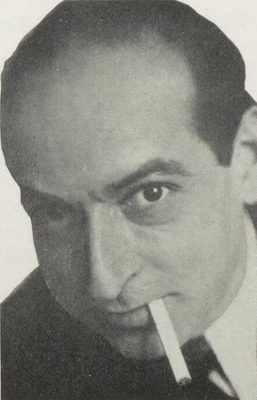Irsai István
1896 - 1968

Irsai Istvan Pesach Ir-shay
Istvan Irsai or Pesach Ir-Shay was an important poster artist, graphic designer and architect in Hungary and in Israel. Irsai’s original style makes him one of the greatest masters of modernist and constructivist poster art.
He was born to a non-religious Jewish family, and his father changed his name to Irsai after the Hungarian town Albertirsa. István Irsai finished high shool at a conservatory studying as a violin player. Between 1914 and 1916 he was serving as an officer in the Austro-Hungarian Army during the First World War. He was seriously injured, which put an end to his career as violinist. In 1916 Irsai returned home as veteran liutenant, and he began to study architecture at the Technical University of Budapest, besides finishing his studies at the Academy of Music as a music teacher.
Beginning his career as an architect and furniture designer, he also worked in the field of graphic design. In the early 1920's he was working at the Globus Printing House, where he learned a lot about printing techniques mastering the field, including large scale lithography (which was very useful for his later work).
In 1925 Irsai emigrated to Palestine, where he became an active graphic artist. Hailed as a leading graphic artist in Israel, he developed the first modern Hebrew font, the “Haim.” He was seriously interested in typography and he also wrote a book about the new font. He also designed signets, emblems and other graphic works for instutions in Erec-Israel. He was fond of theatre art, and along with great actors and directors he joined the first Jewish theatres in Palestine, working as a designer. One of these was the famous HaKumkum. Irsai worked as a designer of the thearte's mobile stages. He also designed Bauhaus styled houses in Tel-Aviv, but sadly non of them exist today.
In 1930, Irsai returned to Hungary and built an outstanding career as poster and graphic artist. He immediately had a huge impact, designing numerous seminal posters in the early 1930’s. After most artists have abandoned the modernist style by the second half of the decade, Irsai continued to work in this style and he was highly parised by his contemporaries, including Bortnyik. He designed several purely constructivist poster designs for commercial products.
In 1944, Irsai and his family was on the Kasztner train, which went to the Bergen-Belsen concentration camp. But according to a deal worked out by Rezső Kasztner, he and prominent Jewish families and representatives of the Jewish intelligentsia were rescued from the concentration camp. They were all successfully sent to Switzerland, and from there Irsai emigrated to Israel in 1945.
He settled in Tel Aviv and continues to work as graphic artist, jhe designed important propaganda posters for the newly founded state of Israel. In the last period of his life, he turned to painting and sculpture.
After 1930, when Irsai arrives to the field of Hungarian poster design, Berény and Bortnyik have already abandoned the modernist style, and turned to a classicist, painting-like approach. However, Irai is not only able to bring the constructivist poster style back to life, but he gave it new values. He has designed a poster for the famous cigarette company, “Modiano”, and he became leading graphic artist of the companies Lampart, Tungsram and Nor-coc (two electricity- and a fashion company). He has created original, decorative geometric designs, each of them clear and artistic. He was able to create monumental, vivid designs for every products, even for light bulbs, bath tubs, swimming suits and lamps.
Irsai had a special talent towards typography: his letters are perfectly formed and fitted to the composition. He often uses very interesting perspectives and the effects of the lightning – mainly on the advertisements of electricity products. The products appear on his designs in monumental and clear form, as part of a highly aesthetic composition. Although it would be extremely important to have the whole picture about Irsai work, little is known in Hungary about his oeuvre in Israel.
Many of his ideas were ahead of his time. His vision was to create a complete corporate identity for his clients, which was visible on every single poster, leaflet, etc. Modernism was not only a style but rather an attitde for him, which was dominant in all of his works. House-, interior- or graphic design were threated with the same way of functionalism.












